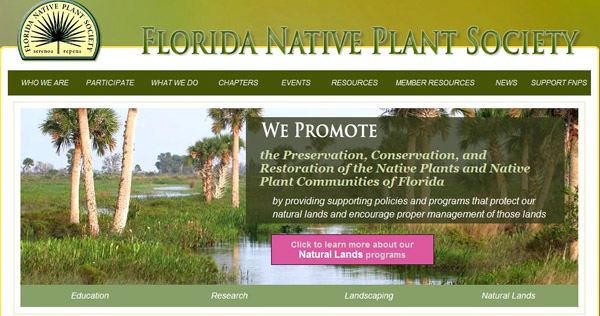FNPS has a brand new website
The Florida Native Plant Society's new website has been under development for years, but as of last week, it's live. While it's available for us to us now, the website committee is still adding new features. It's more than just a nifty new design; it's a whole new editor and content manager. This offers much more flexibility and many more resources for both the membership and the public.
On the home page there is a rotating header with live links to the four areas highlighted: education, research, landscaping, and natural lands.
Under the header is a varying list of news, and below that is the most recent post of this blog, with links back to the most recent blog posts.
The footer highlights some important sections of the website and offers resources for members and its chapters, including the FNPS handbook, which is now a series of wiki pages. (We'll cover the handbook in the later post.)
When you mouse over the top menu items, all but one (Chapters) displays a drop down box with a choice of specific pages. Once you choose a page, there is a navigation feature near the top of the page called breadcrumbs that lets you know where you are and you can click each item to return to a more general page.
On the Mission page, for instance, you can see that it's under the submenu of Who We Are. Be sure to watch the cool slide show that illustrates our mission better than a few words.
My favorite resource is the page on Florida's native plant communities. Each community is illustrated by at least one photo (all by Shirley Denton) and a detailed description. The communities are grouped under the general categories: Xeric Uplands, Dry Mesic Uplands, Mesic Uplands, Wet Flatlands, Seepage Wetlands, Moving Water Wetlands, Floodplain Wetlands, Basin Wetlands, Rocklands, coastal Uplands, Coastal Wetlands, Flowing Water Systems, and finally, Lakes and Ponds.
I know when I was new to the state, I wondered what the heck a flatwoods was. By reading through this informative page, people will have a much better understanding of Florida's ecosystems.
There are other interesting and useful website features that we'll cover in later posts, such as the plant locator. The website committee has done a fantastic job. Thanks to everyone!
Ginny Stibolt
On the home page there is a rotating header with live links to the four areas highlighted: education, research, landscaping, and natural lands.
Under the header is a varying list of news, and below that is the most recent post of this blog, with links back to the most recent blog posts.
The footer highlights some important sections of the website and offers resources for members and its chapters, including the FNPS handbook, which is now a series of wiki pages. (We'll cover the handbook in the later post.)
When you mouse over the top menu items, all but one (Chapters) displays a drop down box with a choice of specific pages. Once you choose a page, there is a navigation feature near the top of the page called breadcrumbs that lets you know where you are and you can click each item to return to a more general page.
On the Mission page, for instance, you can see that it's under the submenu of Who We Are. Be sure to watch the cool slide show that illustrates our mission better than a few words.
My favorite resource is the page on Florida's native plant communities. Each community is illustrated by at least one photo (all by Shirley Denton) and a detailed description. The communities are grouped under the general categories: Xeric Uplands, Dry Mesic Uplands, Mesic Uplands, Wet Flatlands, Seepage Wetlands, Moving Water Wetlands, Floodplain Wetlands, Basin Wetlands, Rocklands, coastal Uplands, Coastal Wetlands, Flowing Water Systems, and finally, Lakes and Ponds.
I know when I was new to the state, I wondered what the heck a flatwoods was. By reading through this informative page, people will have a much better understanding of Florida's ecosystems.
There are other interesting and useful website features that we'll cover in later posts, such as the plant locator. The website committee has done a fantastic job. Thanks to everyone!
Ginny Stibolt








Comments
Thank you for directing users to FANN sources for plants. We'd like to remind users that FloridaNativeNurseries.org lists wholesale sources and PlantRealFlorida.org lists retail sources. And yes, we need more sources in every county - tell your favorite garden center or grower to include more native plants in their inventory.